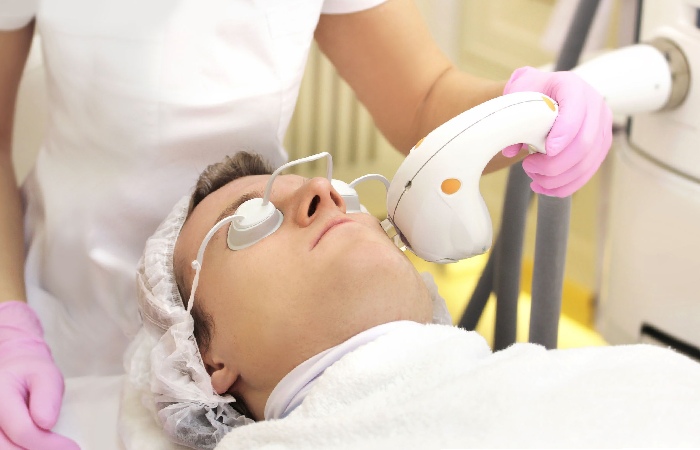There are many different types of hyperpigmentation in freckles, melasma, and liver spots. However, they all change the color of the skin, usually in the form of brown spots. But not all are the focus of cosmetic treatments. In this article, you will learn what forms of hyperpigmentation there are, how pigmentation occurs and what treatment options are available.
Table of Contents
What Types Of Hyperpigmentation?
- Age Spots – Triggers: UV rays and “attacks” by endogenous free radicals.
- Post-inflammatory hyperpigmentation – Trigger: Inflammatory processes, especially in acne-prone skin.
- Melasma/Chloasma – Trigger: Hormonal changes. This form of hyperpigmentation is common in pregnant women.
- Freckles – genetically determined and rarely the goal of cosmetic-dermatological treatment.
In addition to the triggers mentioned, hyperpigmentation can also be caused by increased sensitivity to light. This so-called photosensitivity can be caused by food, ingredients in medicines, or cosmetics.
How Does Hyperpigmentation Occur?
If the skin has brownish spots, it is usually due to hyperpigmentation. An overproduction of melanin or melanocytes causes it. Melanocytes are skin cells that lie in the basal cell layer of the epidermis (upper skin). They produce the color pigment melanin, which affects skin color. The following applies: the more melanin there is, the darker the color.
How Can Hyperpigmentation Be Treated?
An even complexion is of enormous importance for many people. Understandably, hyperpigmentation is therefore perceived as disturbing. Which treatment is suitable for hyperpigmentation depends on the type of pigmentation. The following applies to the “fresher” pigmentation; the easier it can be treated. There are less stubborn spots like PIH or melasma, but age spots are very persistent. Overall, the treatment of hyperpigmentation is comparatively complex and lengthy.
Except for liver spots and moles, however, all forms of hyperpigmentation can usually be treated, and their intensity can at least be reduced with the proper Care. In the case of moles or birthmarks, only surgical intervention remains. You can obtain information on this from your dermatological practice.
If you want to reduce the visibility of pigment spots, PIH, or melasma, you have a choice: you can follow a care concept at home or – also, in addition – rely on the expertise of your beautician.
Your cosmetics institute has a selection of tried and tested tools or treatments to help you with your concerns. These include, for example, microdermabrasion or laser treatments.
But you can also permanently reduce annoying spots on the skin at home. Our recommendation for the visible and lasting reduction of hyperpigmentation: is a whitening solution. The whitening gel uses different approaches to reduce pigmentation in several ways
- A compelling complex of active ingredients reduces the formation of new melanin (tyrosinase inhibition) and blocks melanin transfer into the skin cells.
- Vitamin C enables targeted lightening of the relevant areas.
- Fruit acids stimulate cell renewal and thus ensure an even complexion.
- The active ingredient formula offers protection against oxidative cell damage that promotes hyperpigmentation.
The Optimal Facial Care Routine For Skin With Pigment Disorders
For The Day
1. Cleaning
The morning facial cleansing is mandatory! Use a product with salicylic substances here to benefit from the skin-renewing effect of the active ingredient. We recommend dynamic foam. A facial tonic such as refresh & Care helps restore the skin-neutral p-value.
2. Intensive Care
A brightening serum is the core of the care routine. First, apply the whitening solution to the affected facial areas and gently pat the product on the skin.
By the way – A product-related tingling sensation after application to the skin is harmless!
3. FACIAL CARE FOR THE DAY
After applying the whitening solution in the morning, you should devote sufficient sunscreen. Your skin is now susceptible to light and therefore needs special protection—our recommendation: sun care sensitive SPF 50+ or hydrating cream SPF 50.
For The Night
1. Cleaning
Thorough cleansing of the facial skin is also a must in the evening. It removes sweat, sebum, and impurities deposited on the skin during the day. You will also prepare your skin for the other care products.
2. Face Care
We recommend that you use a suitable fruit acid product in the evening before the whitening solution. The fruit complex plus C is ideally suited. The intensive fruit acid cream with glycolic acid and vitamin C prepares the skin for better absorption of the brightening complex of active ingredients.
3. Intensive Care
After applying a nourishing fruit acid cream, it’s time for the whitening gel. Apply the whitening solution to the affected facial areas and gently pat the product on the skin. For best results, you should use the whitening solution for at least eight weeks.
Conclusion
There is a golden rule for the formation of dark pigmentation in the skin: Consistent protection from UV rays. But unfortunately, the consequences of regular sun exposure continue to be underestimated. Hyperpigmentation – even if it’s just a cosmetic blemish – is part of it and can be effectively prevented.
